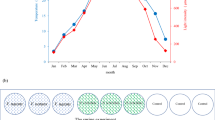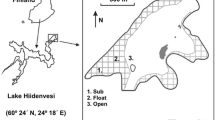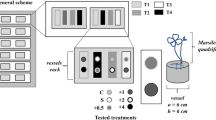Abstract
The effects of floating-leaved, submerged and emergent macrophytes on sediment resuspension and internal phosphorus loading were studied in the shallow Kirkkojärvi basin by placing sedimentation traps among different plant beds and adjacent open water and by sediment and water samples. All the three life forms considerably reduced sediment resuspension compared with non-vegetated areas. Both among submerged (Ceratophyllum demersum, Potamogeton obtusifolius, Ranunculus circinatus) and emergent (Typha angustifolia) plants, resuspension rate was on average 43% of that in the adjacent open water, while within floating-leaved plants (Nuphar lutea) the corresponding value was 87%. The effects of submerged and emergent vegetation increased in the course of the growing season together with increasing plant density. Among floating-leaved vegetation, such seasonal trend in resuspension effects was not observed. Compared with the non-vegetated area, floating-leaved, submerged and emergent plants reduced internal phosphorus loading on average by 21, 12 and 26 mg m−2 d−1, respectively. The effects of floating-leaved plants on resuspension-mediated internal phosphosrus loading were thus comparable to the effects of the other two life forms.
Similar content being viewed by others
References
J. W. Barko W. F. James (1998) Effects of submerged macrophytes on nutrient dynamics, sedimentation, and resuspension E Jeppesen Ma Søndergaard Mo Søndergaard K Christoffersen (Eds) The Structuring role of Submerged Macrophytes in Lakes. Ecological studies Springer--Verlag New York 197–214
Beach Erosion Board, 1972. Waves in inland reservoirs. Technical Memoir 132, Beach Erosion Board Corps of Engineers. Washington DC
L. Bengtsson T. Hellström L. Rakoczi (1990) ArticleTitleRedistribution of sediment in three Swedish lakes Hydrobiologia 192 167–181
J. Bloesch (1994) ArticleTitleA review of methods used to measure sediment resuspension Hydrobiologia 284 13–18
J., Bloesch N. M. Burns (1980) ArticleTitleA critical review of sediment trap technique Schweizeritsche Zeitschrift für Hydrologie 42 15–56
S. Blomqvist L. Håkanson (1981) ArticleTitleA review on sediment traps in aquatic environments Archiv für Hydrobiologie 91 101–132
A. Breukelaar E. H. R. R. Lammens J. G. B. Klein Breteler I. Tátrai (1994) ArticleTitleEffects of benthivorous bream (Abramis brama) and carp (Cyprinus carpio) on sediment resuspension and concentrations of nutrients and chlorophyll a Freshwater Biology 32 113–121
M. N. Bruton (1985) ArticleTitleThe effects of suspendoids on fish Hydrobiologia 125 221–241
R. Carignan (1982) ArticleTitleAn empirical model to estimate the relative importance of roots in phosphorus uptake by aquatic macrophytes Canadian Journal of Fisheries and Aquatic Sciences 39 243–247 Occurrence Handle1:CAS:528:DyaL38Xhs1yhtrY%3D
R. Carignan J. Kalff (1980) ArticleTitlePhosphorus sources for aquatic weeds: water or sediments Science 207 987–989 Occurrence Handle1:CAS:528:DyaL3cXhsVGktbw%3D
G. L. Carper R. W. Bachmann (1984) ArticleTitleWind resuspension of sediments in a prairie lake Canadian Journal of Fisheries and Aquatic Sciences 41 1763–1767
P. A. Chambers J. Kalff (1985) ArticleTitleDepth distribution and biomass of submersed aquatic macrophyte communities in relation to Secchi depth Canadian Journal of Fisheries and Aquatic Sciences 42 701–709
R. L. Chen J. W. Barko (1988) ArticleTitleEffects of freshwater macrophytes on sediment chemistry Journal of Freshwater Ecology 4 279–289 Occurrence Handle1:CAS:528:DyaL1cXkt1Oht7o%3D
C. D. Dieter (1990) ArticleTitleThe importance of emergent vegetation in reducing sediment resuspension in wetlands Journal of Freshwater Ecology 5 467–473
C. M. Duarte J. Kalff (1990) ArticleTitleBiomass and the relationship between submerged macrophyte species and plant growth form Hydrobiologia 196 17–23
R. D. Evans (1994) ArticleTitleEmpirical evidence of the importance of sediment resuspension in lakes Hydrobiologia 284 5–12
A. Gasith (1975) ArticleTitleTripton sedimentation in eutrophic lakes – simple correction for the resuspended matter Verhandlungen der Internationalen Vereinigung für Theoretische und Angewandte Limnologie 19 116–122
D. P. Hamilton S. P. Mitchell (1996) ArticleTitleAn empirical model for sediment resuspension in shallow lakes Hydrobiologia 317 209–220
T. Hellström (1991) ArticleTitleThe effect of resuspension on algal production in a a shallow lake Hydrobiologia 213 183–190
J. Horppila L. Nurminen (2001) ArticleTitleThe effect of an emergent macrophyte (Typha angustifolia) on sediment resuspension in a shallow north temperate lake Freshwater Biology 46 1447–1455 Occurrence Handle1:CAS:528:DC%2BD3MXptVKrsbY%3D
J. Horppila L. Nurminen (2003) ArticleTitleEffects of submerged macrophytes on sediment resuspension and internal phosphorus loading in Lake Hiidenvesi (southern Finland) Water Research 37 4468–4474 Occurrence Handle1:CAS:528:DC%2BD3sXntl2jurs%3D Occurrence Handle14511717
H. O. Jackson W. C. Starrett (1959) ArticleTitleTurbidity and sedimentation at lake Chatauqua, Illinois Journal of Wildlife Management 23 157–168
W. F. James J. W. Barko (1990) ArticleTitleMacrophyte influences on the zonation of sediment accretion and composition in a north-temperate lake Archiv für Hydrobiologie 20 129–142
W. F. James J. W. Barko (2004) ArticleTitleSediment resuspension and light attenuation in Peoria Lake: can macrophytes improve water quality in this shallow system? Hydrobiologia 515 193–201
K. L. Kirk (1991) ArticleTitleInorganic particles alter competition in grazing zooplankton: the role of selective feeding Ecology 72 915–923
F. Koroleff (1979) ArticleTitleMethods for the chemical analysis for seawater Meri 7 1–60
P. Kristensen M. Søndergaard E. Jeppesen (1992) ArticleTitleResuspension in a shallow eutrophic lake Hydrobiologia 228 101–109 Occurrence Handle1:CAS:528:DyaK38XhsFygsbw%3D
J. Murphy J. Riley (1962) ArticleTitleA modified single-solution method for the determination of phosphate in natural waters Analytica Chimica Acta 27 31–36 Occurrence Handle1:CAS:528:DyaF38XksVyntr8%3D
L. Nurminen (2003) ArticleTitleMacrophyte species composition reflecting water quality changes in adjacent water bodies of Lake Hiidenvesi, SW Finland Annales Botanici Fennici 40 199–208
Pekcan-Hekim, Z., J. Horppila, L. Nurminen, & J. Niemistö, 2005. Diel changes in habitat preference and diet of perch (Perca fluviatilis), roach (Rutilus rutilus) and white bream (Abramis björkna). Advances in Limnology 59: 173–187
E. L. Petticrew J. Kalff (1992) ArticleTitleWater flow and clay retention in submerged macrophyte beds Canadian Journal of Fisheries and Aquatic Sciences 49 2483–2489
SAS Institute Inc., 1989. SAS/STAT User’s Guide. Version 6. 4th Edn. Vol. 2. Cary NC, SAS Institute Inc
P. Tallberg J. Horppila J. A. Väisänen L. Nurminen (1999) ArticleTitleSeasonal succession of phytoplankton and zooplankton along a trophic gradient in a eutrophic lake – implications for food web management Hydrobiologia 412 81–94 Occurrence Handle1:CAS:528:DC%2BD3cXhsV2jtbc%3D
A. M. Teeter B. H. Johnson C. Berger G. Stelling N. W. Scheffner M. H. Garcia T. M. Parchure (2001) ArticleTitleHydrodynamic and sediment transport modeling with emphasis on shallow-water, vegetated areas (lakes, reservoirs, estuaries and lagoons) Hydrobiologia 444 1–23
M. S. Van den Berg S. Coops M-L. Meijer M. Scheffer J. Simons (1997) Clear water associated with a dense Chara vegetation in the shallow and turbid Lake Veluwemeer, The Netherlands E. Jeppesen Ma Søndergaard Mo, Søndergaard K Christoffersen (Eds) The structuring role of submerged macrophytes in lakes. Ecological studies Springer-Verlag New York 339–352
J. E. Vermaat L. Santamaria P. J. Roos (2000) ArticleTitleWater flow across and sediment trapping in submerged macrophyte beds of contrasting growth form Archiv für Hydrobiologie 148 549–562 Occurrence Handle1:CAS:528:DC%2BD3cXlvVemsLY%3D
M. Vinni J. Horppila M. Olin J. Ruuhijärvi K. K. Nyberg (2000) ArticleTitleThe food, growth and abundance of five co-existing cyprinids in lake basins of different morphometry and water quality Aquatic Ecology 34 421–431 Occurrence Handle1:CAS:528:DC%2BD3MXkslOhtbc%3D
S. Weisner (1991) ArticleTitleWithin-lake patterns in depth penetration of emergent vegetation Freshwater Biology 26 133–142
R. G. Wetzel (1983) Limnology EditionNumber2 Saunders College Publishing Philadelphia, New York
Author information
Authors and Affiliations
Corresponding author
Rights and permissions
About this article
Cite this article
Horppila, J., Nurminen, L. Effects of different macrophyte growth forms on sediment and P resuspension in a shallow lake. Hydrobiologia 545, 167–175 (2005). https://doi.org/10.1007/s10750-005-2677-9
Received:
Revised:
Accepted:
Issue Date:
DOI: https://doi.org/10.1007/s10750-005-2677-9




